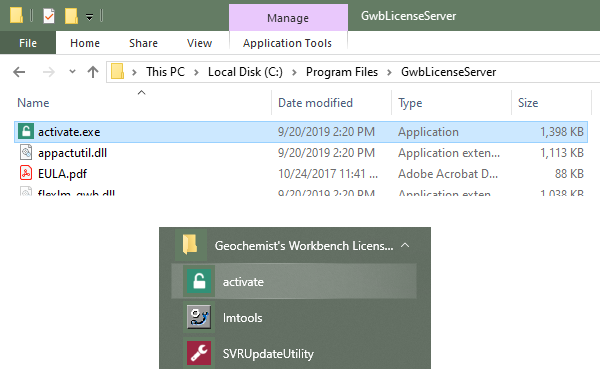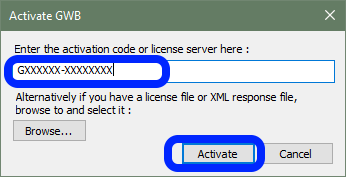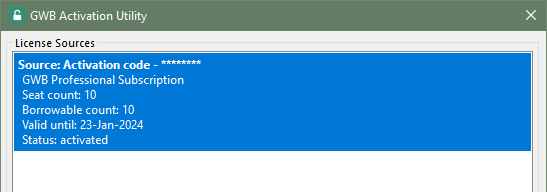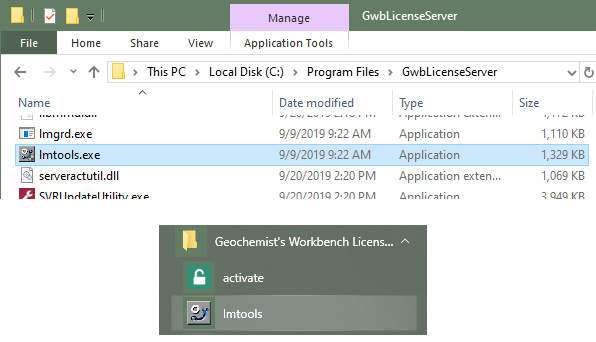Server - advanced installation
This guide is intended for GWB license server setup with custom ports or a specific hostname. To see related topics, please see our Floating license installation page.
If your configuration does not require custom ports or a specific hostname, please see our Basic installation guide.
For guidance on installing the license server on cloud services (e.g. Amazon Web Services), please see our Cloud installation guide.
Preparation
You may install the GWB license server components on any non-ARM CPU based version of Windows currently supported by Microsoft.
Begin by locating the following:
- The server installer executable, for example “SVR1800_setup.exe”, for GWB Server
- Your server activation code, for use on the license server only, looks like “GXXXXXX-XXXXXXXX”
Installation and activation
- Run the server installer executable following the prompts and taking note of the folder where the GWB Server software was installed (e.g. “C:\Program Files\GwbLicenseServer”).
Note that if the “lmgrd.exe“ and “hydrokey.exe” files are moved from their installation folder they will not function correctly unless the entire installation folder is moved as well. - Launch the activation utility from the GwbLicenseServer folder or the Windows start menu

- Select New... in the activation utility

- When the Activate GWB dialog opens, enter your activation code and press Activate

 If you encounter issues with activating your license, please see our activation troubleshooting guide.
If you encounter issues with activating your license, please see our activation troubleshooting guide.
- Close the activation utility
Custom ports and hostname
To set custom ports or specify a hostname for the server, you need to edit “gwb.lic” in the installation directory on the server. While the actual licensing rights are provided by your activation code the license file is still used to configure certain aspects of the server.
You may need to run a text editor as administrator to modify the file.
If you are performing this step on a service currently running, you will need to ReRead License File on the Start/Stop/Reread pane in LMTOOLS after saving the “gwb.lic” file. If you encounter issues with ReReading the license file, please consult our troubleshooting page.
Server ports
Typically custom ports are needed when an external firewall or other access control is between the clients and the server and the firewall needs to know explicitly which ports to allow. In such cases custom ports should be set for both LMGRD and HYDROKEY.
The default ports are:
- LMGRD – First available port between 27000-27010
- HYDROKEY – Chosen randomly
You can set the ports explicitly on the first two lines of the license file, which initially look like:
SERVER this_host ANY VENDOR hydrokey
To run LMGRD on port 27200, for example, and HYDROKEY on port 27201, edit the two lines to read:
SERVER this_host ANY 27200 VENDOR hydrokey port=27201
Server hostname
When LMGRD tells a client how to connect to HYDROKEY, it by default transmits the server's hostname. To check the string sent to the client, open a command line on the server and enter the command “hostname”. In most cases, this is the Windows computer name, without the domain name.
Clients can commonly reach the server using the computer name alone. If a client is set to use a fully qualified domain name (FQDN) to contact the server, it may not be able to connect in this way. The result of such a configuration is an excessively slow or entirely failed license checkout.
Resolve such issues by making sure LMGRD reports HYDROKEY's hostname in the same form clients will use to contact LMGRD. To specify the FQDN of the server, edit the server's license file and change the SERVER line from
SERVER this_host ANY
to
SERVER FQDN ANY
For example, if the server's Windows name is lic with domain set to example.com, the clients would need to connect to it at lic.example.com. In this case, you would change the SERVER line to:
SERVER lic.example.com ANY
As well, you can set the IP address assigned to the server as its hostname
SERVER 192.168.1.100 ANY
As a final note, the hostname on the SERVER line must match the actual windows settings for computer and domain name, or the IP address assigned to the machine. If this restriction becomes an issue, please see instructions for Connecting to HYDROKEY directly.
Configure and start license service
- Launch LMTOOLS, the FLEXlm tools program, from the GwbLicenseServer folder or the Windows start menu

- On the Server/License File pane in LMTOOLS, make sure ”Configuration using Services” is selected

- Complete the Config Services pane as follows

- Specify a Service Name
- Enter the Path to lmgrd.exe file, which is located in the GwbLicenseServer installation folder
- Set as well the Path to the license file, found in the same folder. Note that this file is a generic stub license that causes the vendor daemon to look in trusted storage for licenses that have been activated with the activation utility.
- A Path to the debug log file is optional, but useful when issues arise. Locate the file in a folder where the Windows Local Service user has full control. Setting “C:\ProgramData\gwb_license_server.log” should work well.
- Select the Start Server at Power Up and Use Services options
- Save the service
If you have an existing service and need to add another service simply start typing in the Service Name entry, fill out the rest of the details, and once saved you will have multiple services in the Service Name dropdown to choose between.
- Move to the Start/Stop/Reread pane and click on Start Server

If you have multiple services configured you may first need to choose the service you want to start on the Service/License File pane by selecting the correct service in the listbox.
- Check the log file to make sure LMGRD was able to start the vendor daemon and locate the activation


Now that you have your GWB license server installed and configured successfully, you can proceed to either the basic client installation page for setting up clients individually or the advanced client installation page for setting up multiple clients at once so end users may run the GWB applications
Further support
If you follow the instructions on this page and encounter issues setting up a floating license, please consult our troubleshooting guide.
Return to Floating license installation home